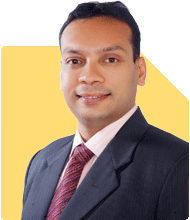Ramalingam Kalirajan |6501 Answers |Ask -Follow
Mutual Funds, Financial Planning Expert - Answered on Jul 06, 2024
He has an MBA in finance from the University of Madras and is a certified financial planner.
He is the director and chief financial planner at Holistic Investment, a Chennai-based firm that offers financial planning and wealth management advice.... more

Hi sir, I am planning to invest in Bajaj ULIP plan for my child future for 7000 per month. Kindly give me your advice
Understanding ULIPs
ULIPs combine insurance and investment. A part of your premium goes towards life insurance, and the rest is invested in equity or debt funds.
Benefits of ULIPs
Dual Purpose: Provides life cover and investment growth.
Tax Benefits: Premiums paid are eligible for tax deductions.
Flexibility: Switch between equity and debt funds.
Evaluating the Bajaj ULIP Plan
Before committing to any ULIP, it’s essential to understand its features and whether it fits your financial goals.
Life Cover
ULIPs offer life insurance, which is crucial for your family’s financial security.
Investment Options
Bajaj ULIP plans allow you to invest in various funds, balancing risk and returns.
Charges
ULIPs have various charges like premium allocation, fund management, and mortality charges. These can impact your returns.
Alternative Investment Options
While ULIPs offer benefits, exploring other investment avenues is wise. Let’s consider mutual funds, PPF, and other instruments.
Mutual Funds
Mutual funds are a popular choice for long-term goals like child education.
Advantages of Mutual Funds
Professional Management: Managed by experts.
Diversification: Reduces risk by spreading investments.
Liquidity: Easy to enter and exit.
Categories of Mutual Funds
Equity Funds: High growth potential but higher risk.
Debt Funds: Stable returns with lower risk.
Balanced Funds: Mix of equity and debt for moderate risk and returns.
Public Provident Fund (PPF)
PPF is a safe, long-term investment with tax benefits.
Advantages of PPF
Guaranteed Returns: Fixed interest rate set by the government.
Tax Benefits: Contributions and returns are tax-free.
Low Risk: Backed by the government.
Systematic Investment Plan (SIP)
SIPs in mutual funds are a great way to build a corpus over time.
Benefits of SIP
Disciplined Investing: Invest regularly, regardless of market conditions.
Power of Compounding: Earn returns on returns.
Rupee Cost Averaging: Buy more units when prices are low, fewer when high.
Comparing ULIPs and Mutual Funds
Both ULIPs and mutual funds have their merits. Here’s a comparison to help you decide.
Flexibility
ULIPs: Limited to switching between funds within the plan.
Mutual Funds: Free to choose from a wide range of funds across different categories.
Costs
ULIPs: Multiple charges can reduce net returns.
Mutual Funds: Lower expense ratios, especially in direct plans.
Returns
ULIPs: Returns depend on fund performance and charges.
Mutual Funds: Potentially higher returns due to lower costs and diverse options.
Strategic Planning for Child's Future
Let’s create a strategy for investing Rs. 7000 per month for your child’s future.
Set Clear Goals
Define your goals, such as higher education or marriage. Estimate the required corpus considering inflation.
Diversify Investments
Diversification helps manage risk. Allocate funds across different asset classes.
Regular Review
Monitor your investments regularly. Adjust your strategy based on performance and changing goals.
Systematic Withdrawal Plan (SWP)
SWP is an effective way to generate regular income from mutual funds during specific milestones in your child's future.
Power of SWP
Regular Income: Provides steady cash flow.
Capital Preservation: Only a part of the investment is withdrawn, allowing the rest to grow.
Tax Efficiency: Only the gains portion is taxed, which can be more tax-efficient than regular income.
Importance of Professional Guidance
Consult a Certified Financial Planner (CFP) to create a customized investment plan. A CFP can provide expert advice and help you navigate complex financial decisions.
Benefits of CFP Guidance
Personalized Advice: Tailored strategies based on your goals.
Regular Monitoring: Continuous review and adjustments.
Risk Management: Strategies to minimize risk and maximize returns.
Tax Planning
Effective tax planning can enhance your savings and investment returns.
Utilize Tax-Advantaged Accounts
Maximize contributions to PPF and other tax-saving instruments to reduce taxable income.
Plan Withdrawals Wisely
Strategize withdrawals to minimize tax liability. For example, PPF withdrawals are tax-free.
Insurance Needs
Ensure you have adequate life and health insurance to protect your family’s financial future.
Life Insurance
Evaluate your life cover needs. Ensure your family is financially secure in your absence.
Health Insurance
Adequate health insurance is crucial to cover medical emergencies and avoid depleting your savings.
Building an Emergency Fund
An emergency fund provides financial security in case of unexpected events.
Importance of Emergency Fund
Financial Cushion: Covers unforeseen expenses.
Prevents Debt: Avoids taking loans during emergencies.
Regular Review and Rebalancing
Regularly review your investment portfolio. Rebalance it annually to maintain the desired asset allocation and achieve optimal returns.
Final Insights
Planning for your child’s future is a commendable goal. While ULIPs offer benefits, considering alternative investment options like mutual funds and PPF can provide higher returns and flexibility. Consult a Certified Financial Planner (CFP) for personalized advice. Stay disciplined, focused, and regularly review your investments to ensure a bright future for your child.
Best Regards,
K. Ramalingam, MBA, CFP,
Chief Financial Planner,
www.holisticinvestment.in
Best Regards,
K. Ramalingam, MBA, CFP
Chief Financial Planner
www.holisticinvestment.in
You may like to see similar questions and answers below
Ramalingam Kalirajan |6501 Answers |Ask -Follow
Mutual Funds, Financial Planning Expert - Answered on Jul 12, 2024
Ramalingam Kalirajan |6501 Answers |Ask -Follow
Mutual Funds, Financial Planning Expert - Answered on Jul 08, 2024
Milind Vadjikar |315 Answers |Ask -Follow
Insurance, Stocks, MF, PF Expert - Answered on Oct 02, 2024
Ramalingam Kalirajan |6501 Answers |Ask -Follow
Mutual Funds, Financial Planning Expert - Answered on Oct 03, 2024
Dr Dipankar Dutta |653 Answers |Ask -Follow
Tech Careers and Skill Development Expert - Answered on Oct 04, 2024
Krishna Kumar |377 Answers |Ask -Follow
Workplace Expert - Answered on Oct 04, 2024
Krishna Kumar |377 Answers |Ask -Follow
Workplace Expert - Answered on Oct 04, 2024
Krishna Kumar |377 Answers |Ask -Follow
Workplace Expert - Answered on Oct 04, 2024
Krishna Kumar |377 Answers |Ask -Follow
Workplace Expert - Answered on Oct 04, 2024
Krishna Kumar |377 Answers |Ask -Follow
Workplace Expert - Answered on Oct 04, 2024
Krishna Kumar |377 Answers |Ask -Follow
Workplace Expert - Answered on Oct 04, 2024
Krishna Kumar |377 Answers |Ask -Follow
Workplace Expert - Answered on Oct 04, 2024
Krishna Kumar |377 Answers |Ask -Follow
Workplace Expert - Answered on Oct 04, 2024
Krishna Kumar |377 Answers |Ask -Follow
Workplace Expert - Answered on Oct 04, 2024
























